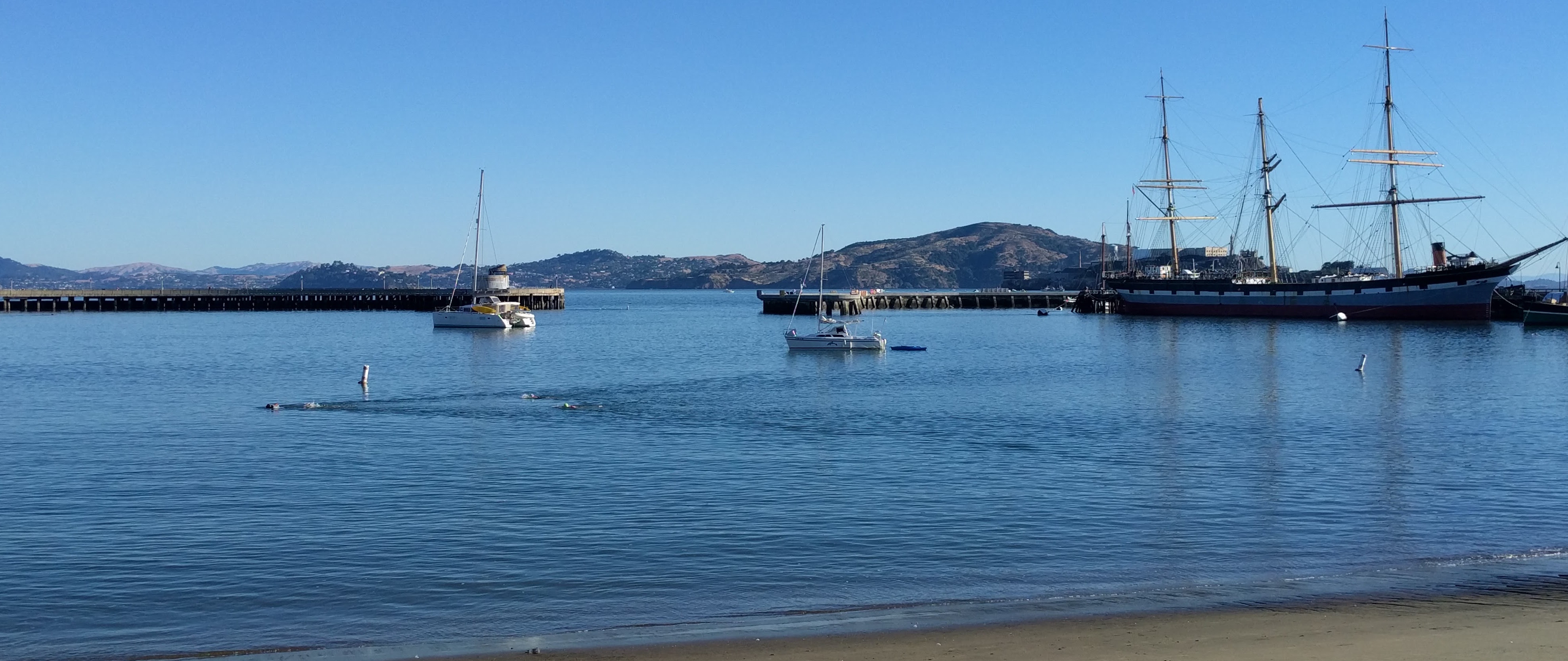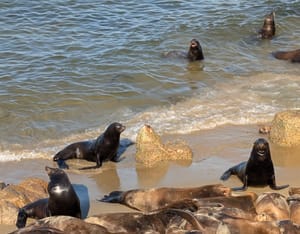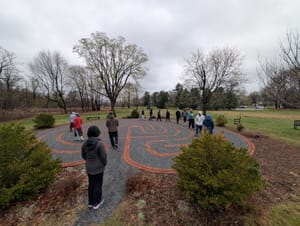I’m going to attempt to swim down SF Bay, from the Golden Gate Bridge to AT&T Park, on July 9.
The distance is about 6.5 miles. The water temperature will probably be about 59 degrees Fahrenheit (plus or minus a couple degrees), or about 15C. Depending on how much of an assist I get from the flood current, it could take over 3 hours. In distance and time it’s longer than any swim I’ve done so far.
Can I do it? I’m not sure yet. I’m pretty confident, and I’m training hard. But I was never a swim team member, came to “serious” swimming fairly late in life, and I’m in no sense particularly athletic. In fact I’m an extremely average swimmer.
People who know me aren’t terribly surprised that I might attempt something like this, given how much I’ve been swimming in the Bay the past couple of years. Swimming is almost a spiritual thing for me.
Since I’m asking people to support this swim — and the health of SF Bay — I figured I ought to try and explain my particular madness a little bit. There are better blogs on open water swimming, and better blogs on swimming long distances. But this is my little story. For the next month, I’m going to share with you a bit about what I’m doing in the water and why.
Most of the time the reaction to learning that I’m a Bay swimmer is something like: That’s crazy. The water is way too cold for me.
It’s true, the water can be chilly. But you get used to it.
I’ve been swimming all my life, from my first swim lessons at age 5 onwards, and I have always enjoyed the water, but it’s only in the past few years that I got really serious about it.
At some point, around 2010, I heard about a coworker who swam in the Bay every morning before coming to work. That’s kind of impressive, I thought! So I decided to try it out myself. I found my way to Coyote Point, a semi-enclosed cove near my home in San Mateo, where there’s a beach. It gets very windy in the afternoons but early in the morning it seemed like a pretty calm place to try swimming in the Bay. It was late summer, and the water was warm-ish, well into the 60s, and I wore a wetsuit. Since I was alone, I stuck very close to shore.
I learned that 60-ish water was warm enough I didn’t need a wetsuit. On the other hand, I also discovered that I could barely swim 50 yards without getting out of breath. Even though I’d been running fairly regularly and considered myself to be in good shape, swimming required a whole different set of muscles and techniques. My stroke was good enough for getting from one side of the pool to the other, and then taking a daiquiri break, but not much more than that.
I returned to Coyote Point a few times, each time swimming a bit longer, and each time marveling as I discovered the watery world, the way the dawn light looked shining through the trees, how the salty water embraced and held me floating at its surface. One morning in particular I remember watching the moon set in the west as the sun was rising in the east, and I was all alone, floating in still, almost mirror-like water, stunned at the beauty of it all.
It wasn’t long before I realized I needed to learn how to swim better, both to enjoy myself more and to keep myself safer. That led me on a journey of improving my stroke, mostly using Total Immersion techniques, off and on over the next few years. (This video showing Shinji Takeuchi’s amazingly smoooooth crawl stroke, is the one that convinced me Total Immersion had something remarkable going for it. The fact that the accompanying music has the refrain “I can see my destiny” might have helped too.) I’m not following all of its techniques any more, but TI caused a major improvement in my ability to swim comfortably over time.
The next step was when I realized that technique alone wasn’t going to transform me into a powerful swimmer: I needed to spend more time training. While I loved the open water, I could never stick to a very serious workout at Coyote Point. I was more like a tourist. So eventually I found my way to a Masters swim group, Burlingame Aquatic Club. “Masters” in this case simply means “old,” not necessarily expert, and “old” means “over 18,” so it’s a really misleading name. In fact, Masters swim groups have adult swimmers of all abilities, from very slow to very fast. And as I found there is no obvious correlation between age or shape and speed. I was in one of the slowest lanes and was regularly getting smoked by older women of a, shall we say, comfortable shape.
But I stuck with it, after awhile, and found that with some moderate training I was getting a little faster and a lot more comfortable in the water. That brought me back into the bay, and in late 2015, I started swimming with my friend Kate at the South End Rowing Club — another perhaps misnamed organization, since in addition to rowing it also supports handball, running, and, yes, swimming. It’s also nowhere near San Francisco’s South End anymore, although it started there; since the 1930s it’s been located on the city’s north shore at Aquatic Park, adjacent to Fisherman’s Wharf.
In Aquatic Park, I discovered an enclosed cove that, while colder than Coyote Point, had stunning views: Ghirardelli Square, Coit Tower, Alcatraz, the Golden Gate Bridge. And the historic ships along Hyde Street Pier: The epic masts of century-old sailing ships, and you could swim right past them, like a pirate! I was in heaven.
Throughout 2016, Kate, her friend Chris, and I had a weekly midday swimming date. We explored Aquatic Park and its environs, in the water and out of it, swimming longer distances as we got used to the water and checking out different lunch options almost every week. It became clear to me that Aquatic Park was a jewel in San Francisco’s crown, an under-appreciated treasure, and it was right there for anyone to jump into it and enjoy. Even better, every day we swam there it was different. Water conditions, air conditions, things swimming about with us or flying overhead: Every single swim was like an amazing new voyage. I couldn’t believe my luck.
Of course, I was hooked.
In my next update, I’ll explain why the cold really isn’t so bad. Honest!
If you’d like to follow along from now until July 9, please add your address using the form below, and I’ll send you a message or two each week, as this story develops.
[xyz-ihs snippet=”swimform”]



